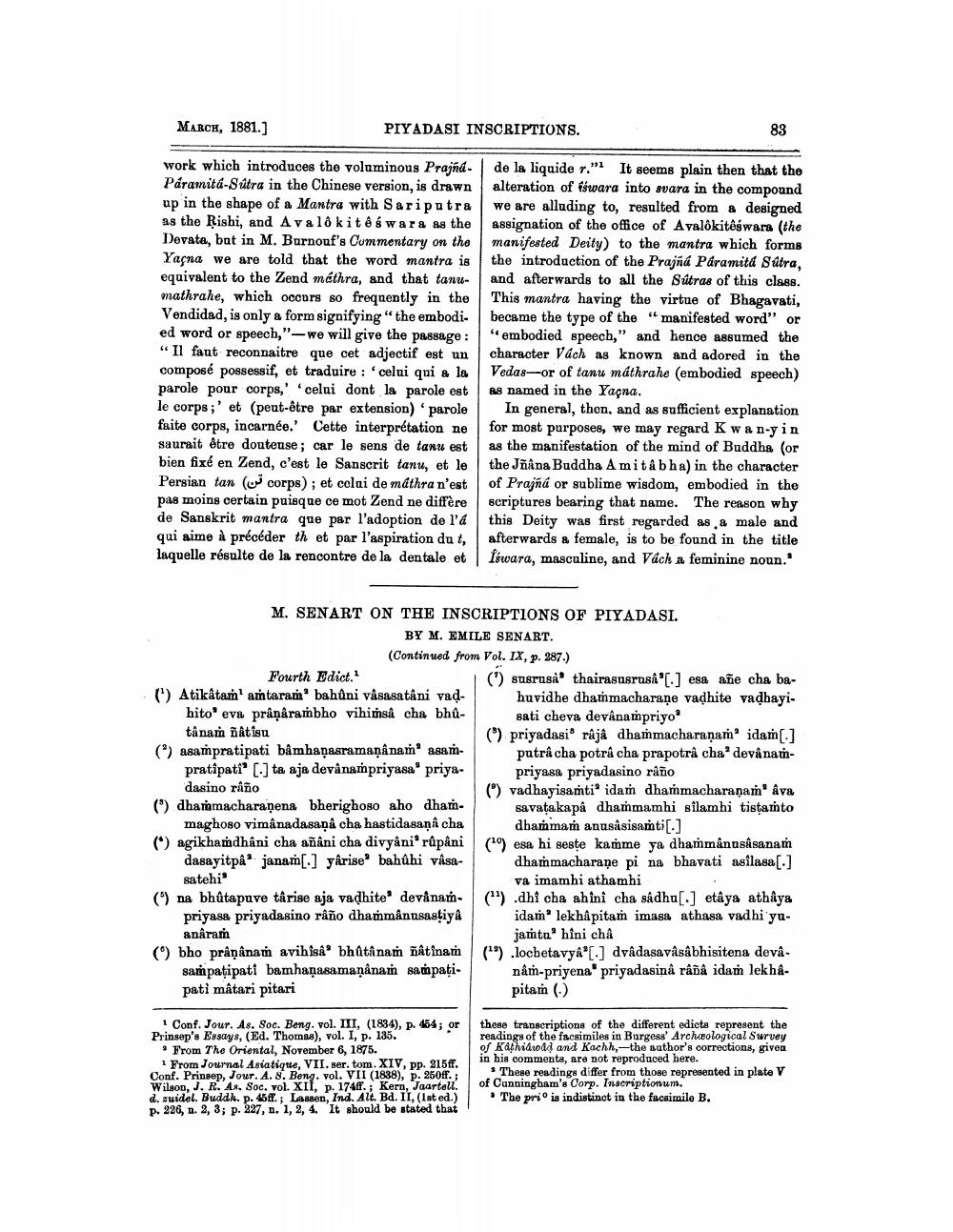________________
MARCH, 1881.)
PIYADASI INSCRIPTIONS.
83
work which introduces the voluminous Prajña. Páramita-sútra in the Chinese version, is drawn up in the shape of a Mantra with Sariputra as the Rishi, and Avaló kit êś wara as the Devata, bat in M. Burnouf's Cummentary on the Yagna we are told that the word mantra is equivalent to the Zend méthra, and that tanumathrahe, which occurs so frequently in the Vendidad, is only a form signifying "the embodi. ed word or speech,"-we will give the passage : "Il faut reconnaitre que cet adjectif est un composé possessif, et traduire : celui qui a la parole pour corps,' 'celui dont la parole est le corps ;' et (peut-être par extension) parole faite corps, incarnée. Cette interprétation ne saurait être douteuse ; car le sens de lanu est bien fixé en Zend, c'est le Sanscrit tanu, et le Persian tan ( corps); et celui de mathra n'est pas moins certain puisque ce mot end ne diffère de Sanskrit mantra que par l'adoption de l'
é qui aime à précéder th et par l'aspiration du t, laquelle résulte de la rencontre de la dentale et
de la liquide r." It seems plain then that the alteration of iswara into svara in the compound we are alluding to, resulted from a designed assignation of the office of Avalokiteswara (the manifested Deity) to the mantra which forms the introduction of the Prajna Paramita Sdtra, and afterwards to all the Sútras of this class. This mantra having the virtue of Bhagavati, became the type of the “manifested word" or "embodied speech," and hence assumed the character Vách as known and adored in the Vedas--or of tanu máthrahe (embodied speech) As named in the Yacna.
In general, then, and as sufficient explanation for most purposes, we may regard Kwa n-yin as the manifestation of the mind of Buddha (or the Jñana Buddha Amitabha) in the character of Prajñá or sublime wisdom, embodied in the scriptures bearing that name. The reason why this Deity was first regarded as a male and afterwards a female, is to be found in the title fswara, masculine, and Vách a feminine noun.'
M. SENART ON THE INSCRIPTIONS OF PIYADASI.
BY M. EMILE SENART.
(Continued from Vol. IX, p. 287.) Fourth Edict.
(1) surusa thairasusrusa'C.] esa añe cha ba(1) Atikātam amtaram' bahûni vâsasatáni vad- huvidhe dhammacharane vadhite vadbayi
hitoeva prânârambho vihisa cha bhu- sati cheva devânampriyo tânam pâtisu
(") priyadasi râjâ dhammacharanam' idam(.] ( asampratipati ba mhanasramaņânam asam
putra cha potrà cha prapotrà cha' devånanpratipati" (.) ta aja devânampriyasa' priya
priyasa priyadasino râño dasino raño
“ vadhayisati idam dhammacharanam' Ava (1) dharmacharanena bherighoso aho dham- savatakapâ dhammamhi silamhi tistamto
maghoso vimânadasaņa cha hastidasana cha dhammaṁ anusâsisamti[.] () agikhamdhani cha añâni cha divyani' růpâni
(9) esa hi seste kamme ya dhammânusâsanam dasayitpa' janam[:] yârise bahůhi vasa- dharmacharaṇe pi na bhavati asilasa[:] satehio
va imamhi athamhi () na bhůtapuve târise aja vadhite' devånam- () .dhi cha ahini cha sådhu[.] etâya athaya
priyasa priyadasino râño dhammânusastiyê idam lekhâpitam imasa athasa vadhi yuanâram
jamtahini cha ( bho prânânamn avihisa' bhûtânam ñåtinam () .lochetavyA'[.] dvadasavâsâbhisitena deva
sampatipati bamhaņasamaņânam sampati- nån-priyena' priyadasinå råñâ idam lekhapati mâtari pitari
pitam (.)
Conf. Jour. As. Soc. Beng. vol. III, (1834), p. 164; or Prinsep's Essays, (Ed. Thomas), vol. I, p. 135.
• From The Oriental, November 6, 1875.
1 From Journal Asiatique, VII. ser. tom. XIV, pp. 215ff. Conf. Prinsep, Jour. 4. 8. Beng. vol. VII (1838), p. 250ff.; Wilson, J. R. As. Soc. vol. XII, p. 174ff.; Kern, Jaartell. d. suidel. Buddh. p. 45ff. Lassen, Ind. Alt. Bd. II,(int ed.) p. 226, n. 2, 3; p. 227, n. 1, 2, 4. It should be stated that
these transcriptions of the different edicta represent the readings of the facsimiles in Burgess' Archeological Survey of Kathi and Kachh, the author's corrections, given in his comments, are not reproduced here.
These readings differ from those represented in plate V of Cunningham's Corp. Inscriptionum.
The priis indistinct in the facsimile B.




